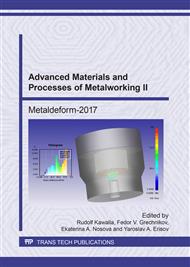p.240
p.246
p.255
p.262
p.269
p.275
p.285
p.290
p.296
Сomputer-Aided Engineering of the Process of Injection Molding Articles Made of Composite Materials
Abstract:
This article investigates the process of filling the stator vanes of the compressor of short-fiber polymer composite material PEEK with 40% of the reinforcing carbon fiber. The article defines the conditions of filling, depending on process parameters. The technique of optimization of process parameters of injection molding articles of complex geometry made of short-fiber polymer composites (stator blade) is tried out. The technique is based on the analysis of numerical simulation of the filling process and the orientation of the reinforcing fibers by the finite element method from the field of rational modes of casting with the use of 3-layer radial basis neural network. In the end, it is established that the desired orientation of carbon fiber (the maximum value of the orientation tensor) to the greatest extent depends on the speed of injection of the melt, for which the minimum temperature of the mold, ensuring complete filling of the form, should be maximized.
Info:
Periodical:
Pages:
269-274
Citation:
Online since:
July 2017
Authors:
Price:
Сopyright:
© 2017 Trans Tech Publications Ltd. All Rights Reserved
Share:
Citation:


